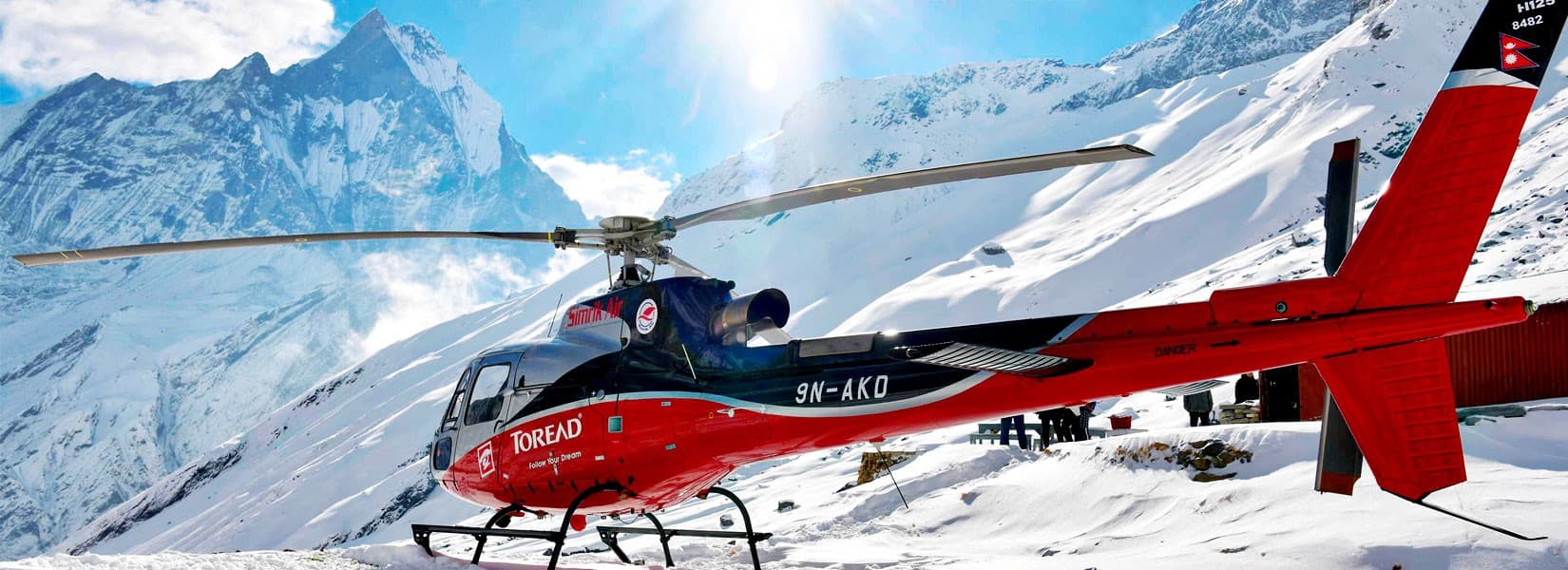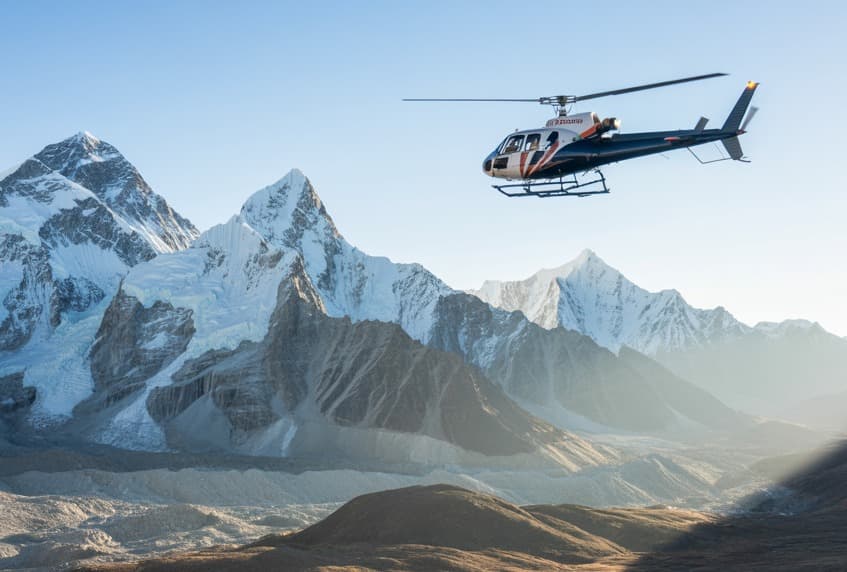Ever stared at those jaw-dropping photos of the Annapurna range and thought, "I wonder what it looks like from up there?" Well, adventure seeker, helicopter tours in the Annapurna region aren't just for National Geographic photographers anymore. Picture yourself hovering above one of the world's most spectacular mountain landscapes, the morning sun glinting off snow-capped peaks while you sip hot tea from a thermos. No trekking permits. No altitude sickness. Just pure, unfiltered Himalayan magic.
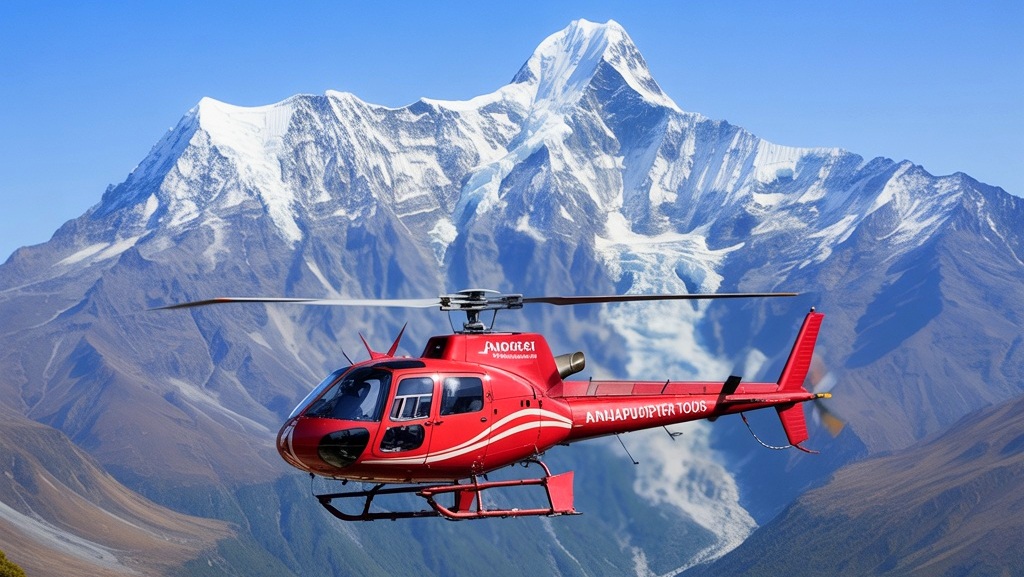
A helicopter tour in the Annapurna region delivers what would take weeks of trekking in just a few breathtaking hours. You'll soar past the tenth highest mountain in the world, cruise alongside iconic peaks, and even touch down for breakfast with a view that most people only see on screensavers.But here's what most tour companies won't tell you about these flights...
Overview of Annapurna Region Helicopter Tours
Unique aerial experience over the Himalayan landscapes
We offer an exhilarating aerial adventure over the majestic Annapurna region, providing a bird's-eye view of one of Nepal's most stunning landscapes. Our helicopter tour takes you soaring above the Annapurna massif, allowing you to witness the breathtaking panoramic views of snow-capped peaks including Annapurna I (8,091m), Dhaulagiri (8,167m), Machhapuchhre (Fishtail) (6,993m), Nilgiri (7,061m), and Hiunchuli (6,441m). The spectacular 360-degree vistas of these towering mountains create an unforgettable experience that simply cannot be matched by ground-level perspectives.
Time-efficient alternative to traditional trekking
Our Annapurna Base Camp helicopter tour presents a perfect solution for travelers with limited time. While traditional trekking to Annapurna Base Camp typically requires 7-14 days of hiking through challenging terrain, our helicopter tour accomplishes this journey in just 1-2 hours. This time-efficient alternative allows you to reach the iconic base camp at 4,130 meters altitude without the physical demands of multi-day tre kking. For those who are short on vacation days but still want to experience the magnificence of the Himalayas, this tour offers the ideal compromise between time constraints and mountain exploration.
Accessibility for all travelers regardless of physical ability
We've designed our helicopter tours to be inclusive for travelers of all ages and physical conditions. Unlike trekking, which demands considerable stamina, acclimatization, and physical fitness, our helicopter tours make the Annapurna region accessible to everyone. Whether you're traveling with elderly family members, young children, or have mobility limitations, you can still witness the splendor of the Annapurna sanctuary. This accessibility ensures that the breathtaking beauty of Nepal's mountains isn't limited only to those capable of strenuous hiking, but can be enjoyed by all adventure enthusiasts regardless of their physical capabilities.
Safety features and professional pilots with mountain flying experience
We prioritize your safety above all else on our helicopter tours. Our fleet is equipped with state-of-the-art safety features, including oxygen cylinders (4-5 liters), regulators, and high-tech top-out masks to provide immediate aid in case of emergencies such as altitude sickness. All our helicopters undergo rigorous maintenance checks to ensure optimal performance in high-altitude conditions. Our pilots are highly experienced professionals specifically trained in mountain flying techniques, with extensive knowledge of the Himalayan terrain and weather patterns. They are experts at navigating the unique challenges presented by high-altitude flights and are familiar with all safety protocols required for Himalayan aviation operations. With their expertise guiding your journey, you can relax and enjoy the spectacular views with complete peace of mind.
Highlights and Key Attractions
A. Annapurna Base Camp panoramic views (4,130m)
At the heart of our helicopter tour lies the breathtaking Annapurna Base Camp at 4,130 meters. When we land at ABC, we're treated to a natural amphitheater surrounded by majestic peaks. The 360-degree panorama includes Annapurna I (8,091m), the world's 10th highest mountain, along with Annapurna South (7,219m), Hiunchuli (6,441m), and Gangapurna (7,454m). The sunrise casting golden rays across these snow-capped giants creates a magical atmosphere that photography enthusiasts will treasure forever. We spend approximately 30 minutes at the base camp, giving our guests ample time to soak in these spectacular views and capture unforgettable memories.
B. Majestic Machapuchare (Fishtail Peak)
One of the most distinctive mountains you'll witness during our helicopter tour is Machapuchare, commonly known as Fishtail Peak due to its unique twin-peaked shape. Standing at 6,993 meters, this sacred mountain has never been officially climbed out of respect for local beliefs. As we fly, you'll get unparalleled views of this revered peak from various angles. The mountain's dramatic ridges and pristine snowy slopes make it a photographer's dream and one of the most recognizable silhouettes in the Himalayas. Its proximity to the Annapurna Base Camp means we'll enjoy spectacular views of this mountain throughout much of our journey.
C. Pokhara city and Phewa Lake from above
Our helicopter tour begins with magnificent aerial views of Pokhara, Nepal's beautiful lakeside city. As we lift off, you'll see the stunning Phewa Lake sparkling below, surrounded by the city's colorful buildings and lush green hills. The perspective from above reveals why Pokhara is known as the jewel of Nepal's western region. We'll also fly over the crystal-clear Seti River and its impressive gorge. This bird's-eye view of Pokhara offers a unique perspective of famous landmarks like Sarangkot viewpoint, World Peace Pagoda, and Pumdikot that few travelers get to experience.
D. Traditional villages like Ghandruk and Ghorepani
From our helicopter, we'll soar above charming traditional settlements including Ghandruk and Ghorepani, heartlands of Gurung and Magar culture. These hillside villages, with their terraced fields and scattered thatched houses, offer a glimpse into authentic rural Himalayan life. Normally, reaching these remote communities requires days of trekking, but our helicopter tour allows you to witness their beauty without the physical exertion. You'll see how generations of mountain people have adapted to life in harmony with the challenging yet beautiful Himalayan environment, creating sustainable communities that preserve ancient traditions.
E. Diverse landscapes from terraced fields to alpine meadows
Our journey showcases Nepal's remarkable geographical diversity within a short distance. We'll fly over verdant valleys with meticulously terraced farmlands, then quickly transition to dense rhododendron forests, especially vibrant with red and pink blooms during spring (March-May). As we gain altitude, the landscape transforms into alpine meadows and finally, the dramatic glacial moraines and snowfields surrounding the base camp. This incredible variety of ecosystems within the Annapurna Conservation Area, Nepal's largest protected region, is home to diverse flora and fauna. Lucky visitors might even spot rare wildlife like Himalayan tahr, musk deer, or if extremely fortunate, the elusive snow leopard from above.
Popular Helicopter Tour Destinations
A. Annapurna Base Camp tours with landing opportunities
Our Annapurna Base Camp helicopter tour offers an extraordinary way to experience the grandeur of the Annapurna region without the physical demands of trekking. The journey begins from Pokhara, taking you directly to the heart of the Annapurna Sanctuary at 4,130 meters. During this breathtaking flight, we soar over lush valleys, terraced fields, and traditional villages, providing unparalleled views of the Annapurna massif.
Upon landing at Annapurna Base Camp, we give you approximately 20-30 minutes to explore the area, take photographs, and marvel at the 360-degree panoramic views of surrounding peaks including Annapurna I (8,091m), Annapurna South (7,219m), Machapuchare (6,993m), and Hiunchuli (6,441m). Here, you can enjoy a hot breakfast or tea while surrounded by some of the world's most magnificent mountains.
Our experienced pilots ensure your safety throughout the journey, navigating the Himalayan terrain with expertise and precision. The entire tour typically lasts about 2-3 hours, including the ground time at the base camp.
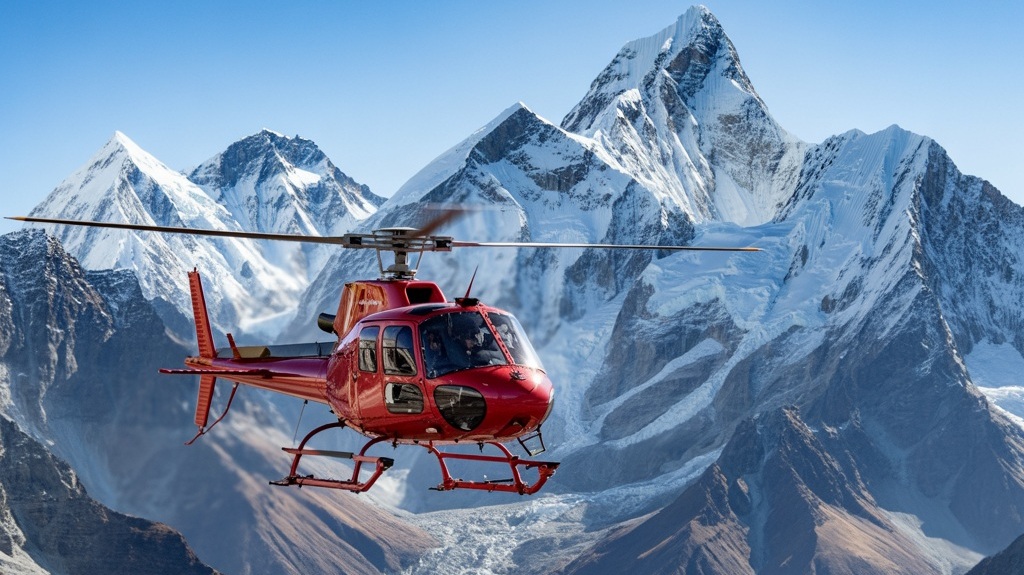
B. Poon Hill sunrise experiences (3,210m)
Flying over Poon Hill offers a completely different perspective than the popular trekking route. While the helicopter doesn't normally land at Poon Hill itself, we include it in our flight path to give you spectacular aerial views of this famous viewpoint situated at 3,210 meters.
During the early morning hours, we time our flights to coincide with the magical sunrise over the Annapurna and Dhaulagiri ranges. The golden rays illuminating the snow-capped peaks create a truly mesmerizing spectacle. From the air, you'll witness the sprawling panorama that makes Poon Hill such a sought-after destination, including views of Annapurna South, Machapuchare, and Dhaulagiri.
This aerial experience over Poon Hill complements our Annapurna Base Camp landing, giving you comprehensive coverage of the region's most iconic locations without the multi-day trek usually required to reach these viewpoints.
C. Mardi Himal Base Camp spectacular views (4,350m)
The Mardi Himal Base Camp helicopter tour takes you to one of the less-visited but equally stunning regions in the Annapurna range. Located at an elevation of 4,350 meters, Mardi Himal Base Camp offers incredible views of the Annapurna massif from a different angle.
As we fly toward Mardi Himal, we pass over diverse landscapes of rhododendron forests, alpine meadows, and rocky terrain. The highlight is the close-up view of Machapuchare (Fishtail Mountain), which appears dramatically different from this western perspective.
Landing at Mardi Himal Base Camp, we provide time for you to experience the tranquility of this remote location. The panoramic views include Mardi Himal itself, Machapuchare, Annapurna South, and Hiunchuli. This location is perfect for photography enthusiasts looking to capture unique angles of these famous peaks without the crowds typically found at more popular destinations.
D. Ghandruk and Landruk cultural villages
Our helicopter tours also include flyovers of the charming Gurung villages of Ghandruk and Landruk, offering a glimpse into the rich cultural heritage of the region. These traditional settlements, with their distinctive stone houses and terraced fields, provide a fascinating contrast to the towering mountains in the background.
Ghandruk, one of the largest Gurung villages, is known for its preservation of traditional lifestyle and architecture. From the air, you can appreciate the layout of this mountain village, with its stone pathways and traditional houses adorned with colorful flowers.
Similarly, Landruk offers spectacular views of the Annapurna range and Modi Khola valley. While our primary helicopter tours focus on mountain landings, we can arrange special landing tours to these cultural villages upon request, allowing you to briefly explore these communities and interact with locals.
By including these cultural settlements in our flight path, we ensure that your helicopter tour encompasses not just the natural beauty of the Himalayas but also provides insights into the lives of the people who call these mountains home.
Tour Packages and Options
A. Kathmandu to Annapurna Base Camp (3-4 hours)
Our Kathmandu to Annapurna Base Camp helicopter tour offers a comprehensive experience that takes approximately 3-4 hours in total. The journey begins with an early morning pickup from your hotel around 5:30 AM, followed by a drive to Kathmandu Airport. At 6:30 AM, you'll board a flight to Pokhara, which takes about 25 minutes. From Pokhara, we'll fly directly to Annapurna Base Camp at 7:30 AM, where you'll have the opportunity to explore the stunning surroundings, take photographs, and enjoy a light breakfast amid the majestic Himalayan peaks.
After spending approximately 30 minutes at the base camp, we'll fly back to Kathmandu, with the entire journey completed by 10:30 AM when we drop you back at your hotel. This package provides an efficient way to experience the grandeur of the Annapurna region without the physical demands of trekking.
B. Pokhara to Annapurna Base Camp (1 hour)
For travelers already in Pokhara or those looking for a shorter option, our Pokhara to Annapurna Base Camp helicopter tour is perfect. This one-hour journey provides the same breathtaking views but with less travel time. The itinerary begins with a 5:30 AM pickup from your Pokhara hotel and transfer to Pokhara Airport. At 6:00 AM, the helicopter departs for Annapurna Base Camp, arriving approximately 20 minutes later.
You'll have around 30 minutes to explore the base camp, take in the panoramic mountain views, and capture memorable photographs. The helicopter then returns to Pokhara by 7:30 AM. This option is ideal for those with limited time or who prefer to maximize their time in Pokhara while still experiencing the magnificence of the Annapurna massif.
C. Mardi Himal helicopter tour from Pokhara
Our Mardi Himal helicopter tour from Pokhara offers an alternative perspective of the Annapurna region. This tour follows a slightly different route, taking you over the beautiful Mardi Himal trek route and providing spectacular views of Mt. Machhapuchhre (Fishtail) and the surrounding peaks.
The flight departs from Pokhara and flies over picturesque landscapes, including lush forests, terraced fields, and traditional villages. Landing at Mardi Himal High Camp offers a different vantage point for viewing the Annapurna range compared to ABC. Some travelers prefer this location as it provides excellent panoramic views that some argue are even better than those from Annapurna Base Camp itself.
D. Ghandruk village aerial excursion
For those interested in combining natural beauty with cultural insights, our Ghandruk village aerial excursion offers a unique experience. This helicopter tour takes you over the charming Gurung village of Ghandruk, known for its traditional stone houses, rich cultural heritage, and stunning mountain backdrops.
The flight provides aerial views of the village nestled against the hillside, with terraced fields and surrounding landscapes. This tour can be combined with a landing at a viewpoint that offers excellent vistas of the Annapurna range. It's an ideal option for travelers who want to appreciate both the cultural and natural dimensions of the region without the time commitment of a trek.
Each of these helicopter tour options can be arranged either as a private charter or as a group joining tour. Private charters provide flexibility in scheduling and personalization, while group joining options offer a more cost-effective way to experience these breathtaking aerial adventures, with prices starting from USD 500 per person based on sharing.
Best Seasons for Annapurna Helicopter Tours
Spring (March-May): Rhododendron blooms and clear visibility
Spring offers one of the most magical times to experience the Annapurna region by helicopter. From March to May, we witness nature come alive with vibrant rhododendron forests in full bloom across the hillsides. These stunning red, pink, and white flowers create a colorful tapestry against the backdrop of snow-capped mountains, making for breathtaking aerial photographs.
During spring, we enjoy relatively stable weather conditions with clear blue skies, especially in the mornings when most of our helicopter tours operate. The visibility is excellent, providing unobstructed views of the Annapurna massif including Annapurna I (8,091m), Annapurna South (7,219m), and the iconic Machapuchare (6,993m).
The temperatures are moderate and pleasant during this season, typically ranging from 15-25°C at lower elevations and 0-5°C at the base camp altitude (4,130m). This comfortable climate makes your brief landing at Annapurna Base Camp more enjoyable as you take in the panoramic mountain views.
Autumn (September-November): Crystal clear mountain views
Autumn reigns as the prime season for our Annapurna Base Camp helicopter tours. Following the monsoon rains that wash away dust and debris, the atmosphere becomes incredibly clear, offering the sharpest and most pristine mountain views of the year. The crisp air provides exceptional visibility, allowing us to showcase the full grandeur of the Himalayan panorama.
From September to November, we fly under brilliant blue skies that create a stunning contrast with the snow-white peaks. The stable atmospheric conditions minimize turbulence, ensuring a smooth and comfortable flight experience. During your landing at the base camp, you'll enjoy mild daytime temperatures between 10-15°C, though mornings can be chilly with temperatures around 0°C.
The autumn landscape below transforms into a palette of gold, amber, and russet as the foliage changes color, adding another dimension of beauty to your aerial journey. The trails visible from above are dry and well-defined, giving you a perfect perspective on the trekking routes that would otherwise take days to navigate.
Winter (December-February): Snow-covered dramatic landscapes
Winter helicopter tours to Annapurna Base Camp offer a completely different but equally magnificent experience. From December to February, we witness the entire region transformed into a pristine winter wonderland. The mountains, valleys, and hillsides are blanketed in fresh snow, creating dramatic landscapes that are simply breathtaking from the air.
The winter air is remarkably clear and pollution-free, providing exceptional long-distance visibility on good weather days. The snow-covered peaks stand out with striking clarity against the deep blue winter sky. While temperatures drop considerably—ranging from -5 to -15°C at base camp—our brief landing times and well-equipped helicopters ensure your comfort and safety throughout the tour.
We carefully monitor weather conditions during winter as sudden snowstorms can occur. Our experienced pilots are well-versed in navigating the Himalayan winter conditions, and we only fly when it's completely safe to do so. While winter tours may require more flexibility with scheduling, the reward is experiencing the Annapurna Sanctuary in its most dramatic and pristine state with significantly fewer visitors.
Summer/Monsoon (June-August): Lush green valleys with weather considerations
The summer monsoon season presents both challenges and unique opportunities for our helicopter tours. From June to August, we see the landscape transform into vibrant shades of green as the rains nourish the valleys, terraced fields, and forests below. This creates a striking contrast with the snow-capped peaks above, offering a different kind of beauty that many travelers find captivating.
While monsoon brings frequent rainfall, the mornings often provide a window of clearer weather that we utilize for our flights. However, we must emphasize that weather conditions can be unpredictable during this season. Cloud coverage may occasionally obscure mountain views, and flights may need to be postponed if conditions aren't suitable.
For those who choose to fly during this less popular season, we offer the benefit of more flexible scheduling and often at reduced rates. The lush, emerald-green landscapes below are at their most verdant, waterfalls cascade down mountainsides at full force, and the agricultural terraces appear as vibrant green staircases climbing the hillsides.
The temperature during monsoon ranges from 18-25°C at lower elevations and 5-10°C at Annapurna Base Camp, making it relatively warm for high-altitude exploration. Despite the challenges, many photographers specifically seek out monsoon flights to capture the dramatic interplay of clouds, mountains, and lush valleys that characterize this unique season.
Health and Safety Considerations
A. Altitude sickness prevention and management
Safety is our top priority when conducting helicopter tours in the Annapurna region. While helicopter tours significantly reduce the risk of altitude sickness compared to trekking, we still take all necessary precautions as our tours can reach elevations above 4,000 meters.
When flying to high altitudes, we carefully monitor our guests for symptoms of Acute Mountain Sickness (AMS). Our helicopters are equipped with supplemental oxygen for emergency use, and our pilots are trained to recognize early signs of altitude-related problems. Landing times at high-altitude spots are kept short (typically 15-30 minutes) to minimize the risk of altitude sickness.
For prevention, we recommend:
-
Staying well-hydrated before and during the tour
-
Eating light meals before flying
-
Informing our staff of any pre-existing medical conditions
-
Following all instructions provided during the pre-flight briefing
Should anyone experience symptoms during the tour, our pilots will immediately descend to a lower altitude, which is the most effective treatment for altitude-related issues.
B. Emergency equipment and protocols
Our helicopter fleet is equipped with comprehensive emergency equipment, including:
-
First aid kits
-
Supplemental oxygen systems
-
Satellite phones for communication in remote areas
-
GPS tracking devices
-
Emergency survival gear
All our pilots undergo extensive emergency response training specific to the Himalayan environment. We maintain close contact with Nepal Army and rescue coordination teams throughout every flight, ensuring rapid assistance if needed.
Our ground staff are trained in emergency protocols and can coordinate medical evacuations if required. Before each tour, we conduct thorough safety checks of all equipment and review emergency procedures.
C. Weather-dependent scheduling flexibility
The weather in the Annapurna region can change rapidly and significantly impacts flight safety. We maintain a strict safety-first approach with no compromises on weather conditions.
Our team utilizes:
-
Advanced weather monitoring systems
-
Real-time meteorological updates
-
Local knowledge of mountain weather patterns
-
Communication with multiple weather stations
If conditions are unfavorable, we will:
-
Reschedule your flight to a better time/day
-
Offer alternative routes when possible
-
Provide full refunds if rescheduling isn't possible
We never pressure our pilots to fly in marginal conditions and appreciate our guests' understanding that postponements are always made with safety in mind.
D. Expert guidance and pre-flight briefings
Before every Annapurna helicopter tour, we provide comprehensive pre-flight briefings that cover:
-
Tour itinerary and what to expect
-
Safety procedures and proper use of equipment
-
Communication protocols during the flight
-
Altitude considerations and what to do if feeling unwell
-
Proper behavior during landings and photo opportunities
Our pilots are not just skilled aviators but also knowledgeable guides who understand the region's geography, culture, and points of interest. They provide expert commentary throughout the flight, enhancing your experience with interesting facts and information about the spectacular landscapes below.
We encourage questions during briefings and ensure every guest feels comfortable and informed before taking to the skies. This preparation is essential for both safety and enjoyment of your Annapurna helicopter adventure.
Essential Packing and Preparation
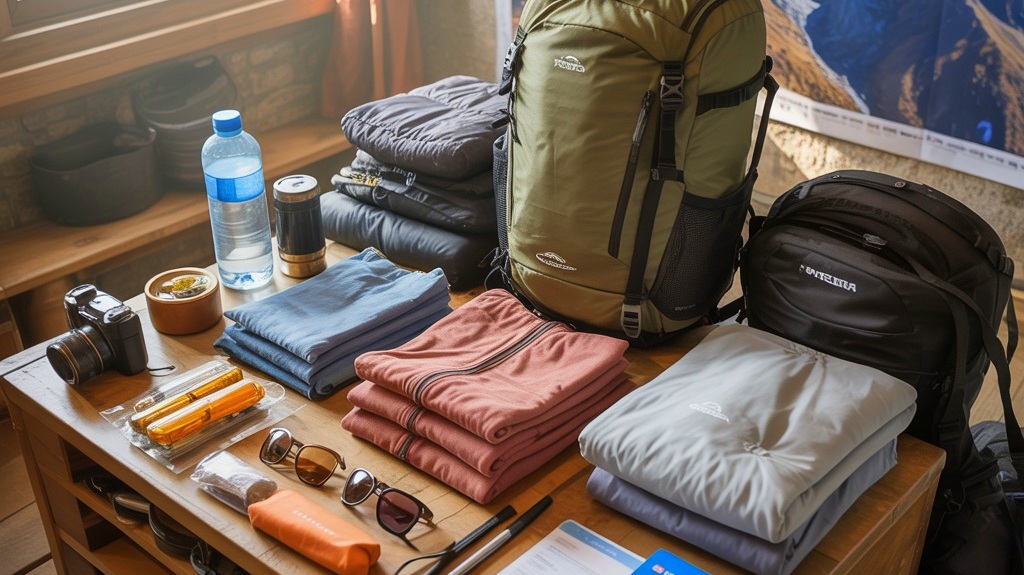
A. Layered clothing for varying temperatures
When embarking on a helicopter tour in the Annapurna Region, proper clothing is crucial as temperatures can vary dramatically between Pokhara and the high-altitude landing sites. We recommend a layered approach that allows you to adjust to changing conditions throughout your journey.
For your base layer, opt for lightweight, moisture-wicking shirts that help regulate body temperature. Over this, pack a warm mid-layer such as a fleece or lightweight sweater. The outer layer should be a windproof and waterproof jacket that protects against cold mountain air and unexpected weather changes.
At Annapurna Base Camp (4,130m), temperatures can drop significantly, so thermal base layers are essential even if your Pokhara departure point is warm. Don't forget warm accessories including a hat, gloves, and a buff or neck gaiter to protect against cold conditions at higher elevations.
B. Photography equipment and considerations
Capturing the breathtaking panoramas of the Annapurna Range is likely a priority during your helicopter tour. We suggest bringing a camera with extra batteries, as cold temperatures at higher altitudes can drain battery life quickly. Memory cards with sufficient storage are essential, as the stunning views will inspire countless photographs.
For those using smartphones, ensure your device is fully charged and consider bringing a portable charger. Polarized sunglasses not only protect your eyes but also help reduce glare when taking photos of snow-capped peaks.
When photographing from the helicopter, be mindful of reflections from windows. Position your camera lens close to the glass to minimize unwanted reflections. Fast shutter speeds are recommended to counteract the helicopter's vibrations and movement.
C. Personal items for comfort and safety
Safety and comfort should be priorities during your helicopter adventure. We recommend carrying a small daypack with essential items including:
-
Sunscreen with high SPF (the UV radiation is intense at altitude)
-
Lip balm with sun protection
-
A reusable water bottle to stay hydrated
-
Light snacks or energy bars
-
Personal medications
-
Hand sanitizer and tissues
-
Sunglasses to protect against intense mountain sunlight
For those concerned about altitude effects during the brief time at Annapurna Base Camp, we provide oxygen cylinders on our tours as a precautionary measure.
D. Documentation and identification requirements
Proper documentation is essential for a smooth helicopter tour experience. We advise all travelers to carry:
-
Valid passport or identification document
-
Travel insurance documents (ensuring coverage for helicopter activities and high-altitude travel)
-
Tour booking confirmation
-
Emergency contact information
-
Copies of relevant permits (which we typically arrange, including the Annapurna Conservation Area Permit if required)
For international travelers, we recommend keeping digital copies of important documents stored securely online as a backup. While our team handles most permit requirements for the helicopter tour, having your personal identification readily available ensures no delays or complications arise.
Remember that weather conditions in the Himalayan region can be unpredictable, so flexibility with your schedule is advisable. Our experienced team monitors conditions closely to ensure both safety and the best possible views during your helicopter adventure.
A helicopter tour in the Annapurna region is one of the most luxurious, time-efficient, and visually spectacular ways to witness the grandeur of the Himalayas. Whether you're seeking a romantic aerial escape, an alternative to strenuous trekking, or a premium way to reach Annapurna Base Camp, this experience offers something truly unforgettable. With breathtaking panoramic views, comfortable flight options, and expert-guided experiences, helicopter tours combine adventure with indulgence. Trust Luxury Holidays Nepal to design the perfect heli-tour that matches your travel dreams, ensuring safety, style, and soul-stirring memories every moment above the clouds.
If you need any further information, please contact us by email: [email protected], Phone: +977- 985 100 5129 (WhatsApp).

